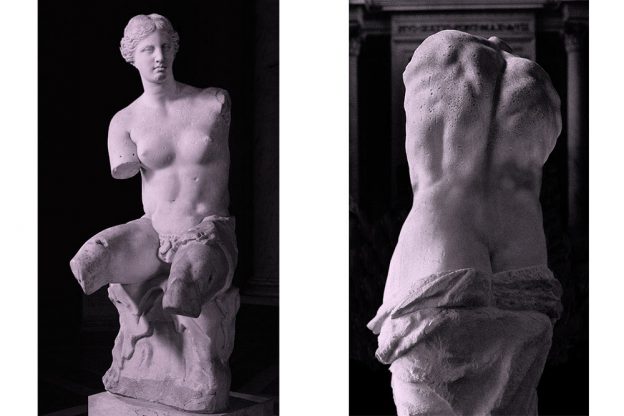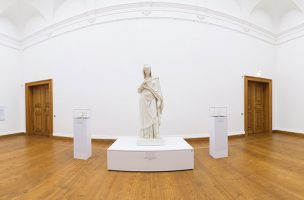Daniel Poveda:
Ancient Modernity
»Von Winckelmann inspiriert – Bauhaus-Künstler zwischen moderner Antike und antiker Moderne«: Der Künstler Daniel Poveda verwandelt den Torso vom Belvedere in einen Hermaphroditen.
When approaching the notion of translation from antique to modern in Winckelmann’s work and its influence, I took into account his special sensibility and sexual orientation in order to make through this artwork a reflection on gender. A valid stance he took as well while trying to balance social sensibilities among his bias social context tinted by puritanism.
Thus, taking into account different tensions on sexuality coming from ancient times among societies, I approach Philosopher Beatriz Preciado’s thoughts on the need for an end of gender assignment. This is done when they suggest to finish the old dichotomy Man-Woman as sign, in order to make reference among one another simply as »Speaking bodies«; a political stance that would avoid the assignation of socially labeled roles coming from the body’s sexual specificities.

Daniel Poveda, Modern Antiquity – Ancient Modernity, Untitled 0, digital collage, 38 x 20 cm
In this manner, I bring back the figure of the hermaphrodite (born of Hermes and Aphrodite), widely represented and recognized among the classic Greek’s aesthetics and mythology. This representation shows an opportunity to point out how different societies have dealt with gender issues, and how yet today difficulties are faced when trying to assign closed roles into bodies through gender. Henceforth, the hermaphrodite body, multiple and plural, shows us the complexity of the human sexual subjectivity, which is difficult to frame and hinder.

Daniel Poveda, Modern Antiquity – Ancient Modernity, Untitled I, digital collage, 38 x 21 cm
At the same time, a similar understanding on identity is pointed out through Aristophanes’ speech on Plato’s Symposium. It explains how Zeus and Apollo severed the human anatomy to make them weaker, once they did »…the two parts longed for each other and tried to come together again«. Therefore, two ideal bodies among the visual culture are assembled through the collage technic; the Venus of Milo and the Belvedere Torso, which are strongly labeled by their gender index, eventually resulting in something other, a third body, not easy to grasp nor assimilate; an unfolding identity.
Moreover, a computational voice (namely Moira) translating the speech from Aristophanes, behaves in a similar way. Once generated through a software or text to speech synthesizer, it is configured to be perceived as a human identity, but eventually it’s just a synchronic configuration of binary codes and algorithms (0-1).
Unter dem Motto »Von Winckelmann inspiriert – Bauhaus-Künstler zwischen moderner Antike und antiker Moderne« haben wir Künstlerinnen und Künstler der Bauhaus-Universität Weimar dazu eingeladen, sich kreativ mit Johann Joachim Winckelmann und seinem Wirken zu beschäftigen. Bis zum Ende der Ausstellung am 2. Juli veröffentlichen wir die unterschiedlichen Ergebnisse dieser künstlerischen Zusammenarbeit wöchentlich im Blog.
Die Ausstellung »Winckelmann. Moderne Antike« ist vom 7. April bis 2. Juli 2017 im Neuen Museum in Weimar zu sehen.






